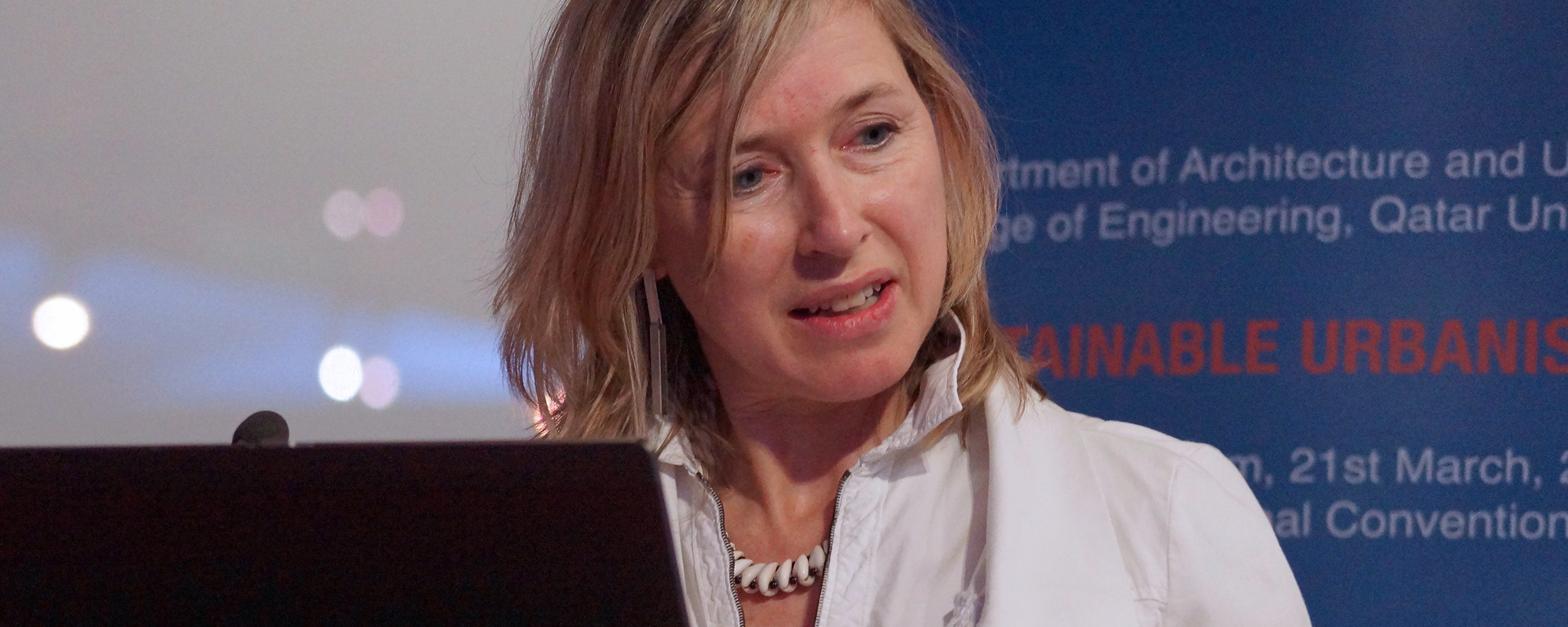 3
Issue 3
3
Issue 3

Johanna Gibbons speaking at Sustainable Urbanism New Directions, University of Qatar, 21 March 2016, © University of Qatar.
Ecological Patchiness
Landscape architect Johanna Gibbons, co-founder of J & L Gibbons in London, describes her practice and research as collaborative. This gives the team multiple perspectives from which to appreciate natural process, to interact with community dynamics, and to develop design and conservation management responses.
We closely observe the micro, the self seeded, the so-called ‘unkept’, where nature has been opportunistic, and we make it our business to understand and articulate its particular beauty, in terms of ecological or community value, locally and strategically.
The All London Green Grid has been in place as Special Planning Guidance (SPG) since 2012 and is embedded in the Greater London Authority’s (GLA) London Plan. The ‘green grid’ conceived back in 2004 deliberately ignores the constraints of administrative boundaries and highlights the potential of London’s gardens, parks, network of spaces in and around housing estates, tree-lined streets, waterways and urban forests as an integrated network offering multiple benefits to city living. Natural Capital, the recent Green Infrastructure Task Force Report by the GLA (Greater London Authority) further reinforces the vital role of nature. It accentuates London’s landscape infrastructure as ‘integral to the capital’s metabolism’.
As boroughs become more dense, the role of the capital’s public realm and green infrastructure becomes ever more vital. Those who live and work in London realise the magnitude of the change that is occurring and the need to ‘sweat’ the benefits of green infrastructure. Transport for London’s Roads Task Force, for instance, acknowledges that roads not only provide movement but also contribute to equitable high-quality living.
In the spirit of sustainable development, local involvement is as important as policy change. The bar must be set high with a commitment to community engagement and deliberative planning. This approach will set new expectations in management of the public realm that embraces amenity benefits and consequent co-benefits of biodiversity, clean air, health and well-being.

Bioreceptive materials, presentation by Johanna Gibbons, Sustainable Urbanism New Directions, 21 March 2016, University of Qatar.
All we need to know in the proper valuation of natural assets is provided by natural systems, the hydrological cycle, the process of decay, the successional forest, the rich urban brownfield meadow, the spawning of fish fry in the river. The reinterpretation of urbanism, somewhere between natural regeneration and urban regeneration, that blends the industrious nature of human activity and ecological resilience within its aesthetic framework, is fertile ground for practice.
Research potential is cross-cutting. Deprivation in access to nature and deficiency in contact with natural processes is linked directly to health indices. Sustainable development is as much to do with pioneering innovative materials as it is in planning for resilient water management. Bio-receptive materials and large species urban forestry could be treated as architecture to help combat heat islands, mitigate energy consumption, address sustainable drainage and reconnect the urban population with nature. Urban forestry could positively support the mental health and well-being of urban populations as cities densify. The more or less fragmented green bits of the city, the urban ecological patchiness, with its dynamic and ephemeral qualities, could acquire new meaning, and new value.
jo@jlg-london.com
Johanna Gibbons
Johanna Gibbons is a landscape architect and founding member of J & L Gibbons, established in Britain in 1986. She studied at Edinburgh College of Art and is a Fellow of the Landscape Institute. She serves on several advisory panels including Historic England, The Forestry Commission, Design South East and HS2. Her particular interests are soil biodiversity and urban forestry. Her expertise concerns heritage, green infrastructure and urban regeneration and she leads on collaborative cross-disciplinary practice at a strategic and local level.
Her award-winning practice was a finalist in the prestigious Rosa Barba International Landscape Prize 2014 and winner of the Landscape Institute President’s Award for the East London Green Grid and Making Space in Dalston. The practice is currently part of a collaborative pilot research project lead by King’s College London exploring urban environments and mental well-being. Johanna Gibbons has recently exhibited as part of the ‘Rethinking the Urban Landscape’ and ‘Urbanistas’ exhibitions, celebrating innovative women in design.